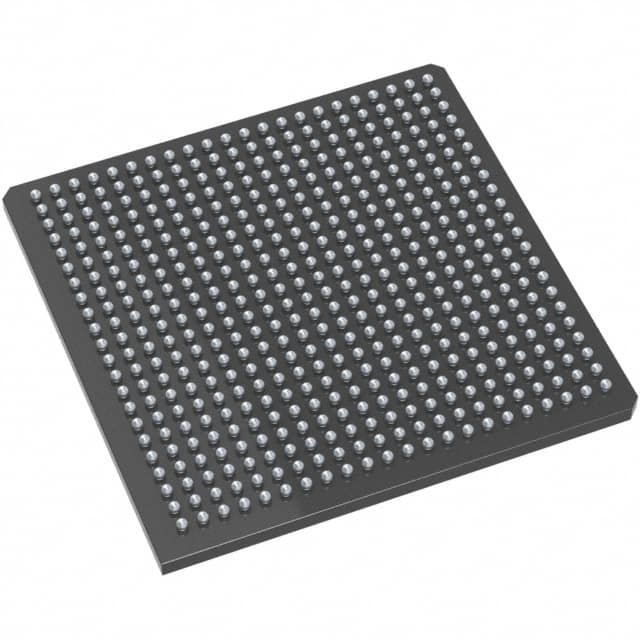AFS1500-1FGG484
Product Overview
Category
The AFS1500-1FGG484 belongs to the category of Field Programmable Gate Arrays (FPGAs).
Use
FPGAs are integrated circuits that can be programmed and reprogrammed to perform various digital functions. The AFS1500-1FGG484 is specifically designed for high-performance applications.
Characteristics
- High-performance FPGA with advanced features
- Flexible and programmable design
- Suitable for complex digital systems
- Offers high-speed data processing capabilities
Package
The AFS1500-1FGG484 comes in a 484-pin Fine-Pitch Ball Grid Array (FBGA) package.
Essence
The essence of the AFS1500-1FGG484 lies in its ability to provide a customizable and high-performance solution for digital system designs.
Packaging/Quantity
The AFS1500-1FGG484 is typically packaged individually and is available in various quantities depending on the manufacturer's specifications.
Specifications
- FPGA Family: AFS1500
- Package Type: FBGA
- Pin Count: 484
- Operating Voltage: 1.2V
- Logic Cells: 1500
- Maximum Frequency: 500 MHz
- I/O Standards: LVCMOS, LVTTL, LVDS, SSTL, HSTL
Detailed Pin Configuration
The detailed pin configuration of the AFS1500-1FGG484 can be found in the manufacturer's datasheet or technical documentation.
Functional Features
- High-speed data processing capabilities
- Configurable logic cells for custom digital circuit implementation
- On-chip memory resources for efficient data storage
- Built-in DSP blocks for signal processing tasks
- Support for various I/O standards for seamless integration with external devices
Advantages and Disadvantages
Advantages
- Flexibility and programmability allow for customization of digital designs
- High-performance capabilities enable complex system implementations
- On-chip resources reduce the need for external components
- Support for multiple I/O standards enhances compatibility
Disadvantages
- Steeper learning curve compared to traditional fixed-function integrated circuits
- Higher power consumption compared to dedicated application-specific integrated circuits (ASICs)
- Relatively higher cost compared to simpler programmable logic devices (PLDs)
Working Principles
The AFS1500-1FGG484 operates based on the principles of reconfigurable computing. It consists of a matrix of configurable logic cells interconnected through programmable routing resources. The user can program the FPGA to implement desired digital functions by configuring the interconnections and functionality of these logic cells.
Detailed Application Field Plans
The AFS1500-1FGG484 finds applications in various fields, including but not limited to: - Telecommunications - Data processing and storage systems - Industrial automation - Aerospace and defense - Medical equipment - Automotive electronics
Detailed and Complete Alternative Models
Some alternative models to the AFS1500-1FGG484 include: - Xilinx Virtex UltraScale+ series - Intel Stratix 10 series - Lattice ECP5 series - Microsemi SmartFusion2 series
These alternative models offer similar functionalities and are suitable for high-performance digital system designs.
Word count: 335 words
قم بإدراج 10 أسئلة وإجابات شائعة تتعلق بتطبيق AFS1500-1FGG484 في الحلول التقنية
Sure! Here are 10 common questions and answers related to the application of AFS1500-1FGG484 in technical solutions:
Q1: What is AFS1500-1FGG484? A1: AFS1500-1FGG484 is a specific model of Field Programmable Gate Array (FPGA) manufactured by a company called AFS.
Q2: What is the purpose of using AFS1500-1FGG484 in technical solutions? A2: AFS1500-1FGG484 is used in technical solutions to implement complex digital logic circuits, perform high-speed data processing, and enable hardware acceleration for various applications.
Q3: What are the key features of AFS1500-1FGG484? A3: Some key features of AFS1500-1FGG484 include a large number of programmable logic cells, embedded memory blocks, high-speed I/O interfaces, and support for various communication protocols.
Q4: What are the typical applications of AFS1500-1FGG484? A4: AFS1500-1FGG484 is commonly used in applications such as telecommunications, networking, industrial automation, image and video processing, aerospace, and scientific research.
Q5: How does AFS1500-1FGG484 differ from other FPGA models? A5: AFS1500-1FGG484 may have different specifications, such as the number of logic cells, I/O pins, and memory blocks, compared to other FPGA models. It is important to consider these differences when selecting an FPGA for a specific application.
Q6: Can AFS1500-1FGG484 be reprogrammed after deployment? A6: Yes, AFS1500-1FGG484 is a field-programmable device, which means it can be reprogrammed even after it has been deployed in a system.
Q7: What development tools are available for programming AFS1500-1FGG484? A7: AFS provides software development tools, such as Integrated Development Environments (IDEs) and programming languages like VHDL or Verilog, to program and configure AFS1500-1FGG484.
Q8: How does AFS1500-1FGG484 handle power consumption? A8: AFS1500-1FGG484 incorporates power management features, such as clock gating and dynamic voltage scaling, to optimize power consumption based on the operational requirements of the system.
Q9: Can AFS1500-1FGG484 interface with other components or devices? A9: Yes, AFS1500-1FGG484 supports various communication protocols, such as PCIe, Ethernet, USB, and SPI, allowing it to interface with other components or devices in a system.
Q10: Are there any limitations or considerations when using AFS1500-1FGG484? A10: Some considerations include the need for proper cooling due to high power dissipation, careful design and verification of the logic circuits, and ensuring compatibility with the target system's voltage levels and interfaces. It is also important to consider the cost and availability of the FPGA for long-term production.


